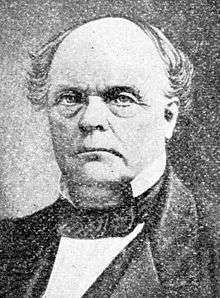Chauncey Rose

Chauncey Rose (December 24, 1794 – August 13, 1877) was a successful American businessman of the 19th century.
Early life
Chauncey Rose was born in Wethersfield, Connecticut to Scottish immigrants on December 24, 1794. Chauncey was one of eight children, all of whom died childless. Two of his brothers, George and John, went on to successful business careers in Charleston, South Carolina and New York City, New York, respectively.
Rose was educated in the common schools of his Connecticut district, and at the age of 23 headed west to the states of Indiana, Illinois, Kentucky, Tennessee and Alabama to find a suitable place to enter into business. He decided upon western Indiana and settled in Rosedale, then known as Dotyville, in Parke County in 1819, where he first turned his attention to milling, building his first mill in Coxville just outside Rosedale. As his revenue grew, Rose expanded into other investment realms in nearby Terre Haute in Vigo County, which was developing into the commerce center of the region.
Rose was instrumental in getting the U.S. Army Corps of Engineers under Major Cornelius A. Ogden, supervisors of the construction the Cumberland Road, to relocate their headquarters from Indianapolis to Terre Haute. When Terre Haute was awarded a district branch of the Second State Bank of Indiana in 1834, Rose furnished a facility in which the bank could operate while awaiting construction of the bank branch. This provided Major Ogden with a secure place to issue payroll. Rose then constructed a fine hotel east of the village, called The Prairie House, so that Ogden and other West Point graduates associated the Corps of Engineers would have a superb residence. This hotel later became the first Terre Haute House, so renamed by Rose in 1855.
Business success
Following a six-year stretch overseeing milling operations in Parke County, Rose moved back to Terre Haute to expand his businesses, and became quite successful. His profits were in turn reinvested in real estate, and he amassed an even larger fortune, some of which he subsequently invested in railroads. In 1847, Rose was the principal founder of the Terre Haute and Richmond Railroad, which was renamed the Terre Haute and Indianapolis Railroad in 1865. He also aided others, including William D. Griswold and Josephus Collett, to establish other railroads.
Philanthropy
Upon the death of his brother John, Chauncey learned that he was the sole heir to an estate worth $1,600,000. Concerned that the laws of New York would prevent the proper fulfillment of his brother’s wishes, Chauncey instituted legal proceedings and, after six years of court battles, won the right to disperse his brother’s estate. Chauncey distributed his brother’s money, totaling $1,500,000 to various charities, mostly in the New York area.
Rose was equally generous with his money in Terre Haute, where his philanthropic activities were reported in an 1875 New York Times article to have exceeded $2,000,000 in currency of that day. Among his numerous benefactors were the Providence Hospital, the Free Dispensary and the Rose Orphan Asylum, to whom he endowed enough money to ensure it would remain permanent.
Rose also contributed enough money to build and endow the Rose Polytechnic Institute (now the Rose-Hulman Institute of Technology). The cornerstone for the college was laid on September 11, 1875 but it did not begin operations until March 5, 1883, long after Rose's death. It remains to this day one of the few colleges solely dedicated to science and engineering. Rose organized it as the Terre Haute School of Industrial Sciences with an initial endowment of $500,000, so that “this institution has a productive capital, exclusive of buildings”.
Significantly, Rose intended none of the institutions funded or founded by him, save the incorporated name of Rosedale to bear his name. Other name ties resulting from posthumous commemorative changes by his grateful recipients.
Rose died in Terre Haute, Indiana on August 13, 1877.
Bibliography
- (1877). "A Dead Millionaire." Chicago Daily Tribune. August 22.
- (1877). "Death of Chauncey Rose." New York Times. August 14.
- Logan, Esaray and William Cronin (1922). History of Indiana From Its Exploration to 1922. Dayton: Dayton Historical Publishing Company.
- US Writers Program. Indiana: A Guide to the Hoosier State. New York: Oxford University Press.
- (1889). "The Rose Polytechnic Institute." Science February 15.
- (1875). "Benefactions of Mr. Chauncey Rose of Indiana, Upwards of $2,000,000 Given Away in Fifteen Years." New York Times. October 11.